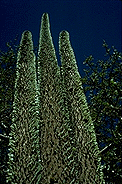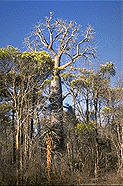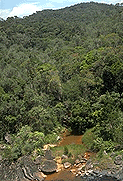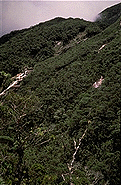



From left to right: Alluaudia ascendens (Didiereaceae) at Andohahela Strict Nature Reserve; forest with Adansonia za (Bombacaceae) en route to Lac Tsimanampetsotsa; Ranomafana National Park at 1,200 m elevation; Marojejy Strict Nature Reserve at 1,800 m elevation.
The following paper was presented at the International Symposium entitled "Natural and Human-induced Change in Madagascar" held at the Field Museum of Natural History in Chicago 2-4 June 1995. The printed version appeared in the symposium volume as follows: Lowry, P. P., II, G. E. Schatz and P. B. Phillipson. 1997. The classification of natural and anthropogenic vegetation in Madagascar. Pp. 93-123 in: S. M. Goodman and B. D. Patterson (eds.), Natural change and human impact in Madagascar. Smithsonian Inst. Press, Washington, D.C.
A historical review of vegetation classification in Madagascar reveals that the classical map and "phytogeographic" territories of Perrier de la Bâthie and Humbert are largely a subjective reflection of climatological factors, and do not adequately reflect fundamental biogeographic patterns. Delimitation of phytochoria based on the distribution patterns of taxa provides an objective framework for comparing and mapping vegetation types using a simple physiognomic classification. The application of this approach in Madagascar would make it possible to test the validity of the classical divisions and circumscribe alternative ones, and to determine the current extent of natural and anthropogenic formations (principally secondary grasslands, often called "prairies", "pseudosteppes", etc., which cover about three quarters of the country). Before the arrival of man, the original woody vegetation types in the drier west (forest, woodland, bushland, etc.) were in a fragile equilibrium and could quickly have been converted to secondary grassland by fires; in the moister center more active human intervention (clearing) was likely required to alter the vegetation. Contrary to recent claims, native grasslands were not widespread immediately prior to the arrival of humans, but were probably restricted to small patches. Today, human impacts can be seen in all Malagasy vegetation types, even supposedly undisturbed "native" forest.
Download zipped file (30.7KB)--Vegetation analysis in Madagascar: a bibliography of relevant publications